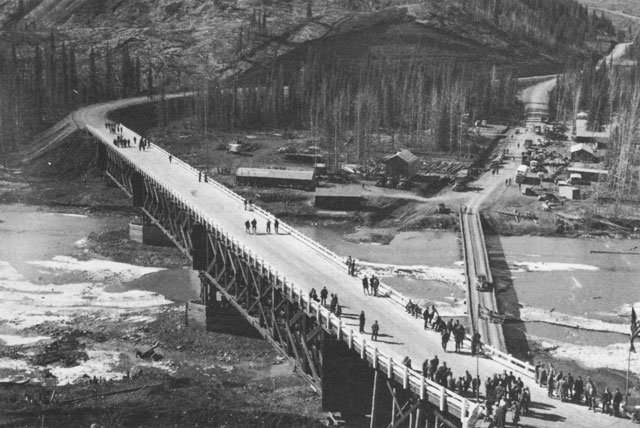The Alaska Highway, (formerly the Alcan Highway), was constructed by U.S. Army Engineers in only 8 months and 12 days, (March to November) at a cost of $135 million. It was built as an emergency war measure to provide an overland military supply route to Alaska. The road is 1,523 miles long and traverses the Canadian Yukon and Alaska. The road Starts at Dawson Creek in British Columbia and ends in Fairbanks, Alaska.
The Alaska portion of the road, arguably the most difficult and hazardous section, was built by the all-black 93rd, 97th and 95th Army Engineer General Service Regiments of the Corps of Engineers over the protests of the United States Army commander for Alaska, General Simon Buckner, Jr.
African Americans were initially kept from taking part in the Alaska Highway project because of objections similar to those of General Buckner. However, due to a severe shortage of manpower the Army decided to send the 93rd, 95th, 97th and 388th regiments to Alaska. NOTE: The 388th Regiment worked primarily on the CANOL Oil Pipeline project.
African American regiments in Alaska were forced to endure the frequent bigotry and prejudice that was so much a part of those times and their living conditions while building the highway were especially harsh. Since they were not permitted to visit the nearby settlements or towns, most of the men were forced to live in tents which gave little or no protection from the freezing Alaskan weather.
Despite the weather, the tents and the lack of food, the men maintained a high morale. For the 95th regiment, this was primarily through the efforts of a Clergyman named Edward G. Carroll, who kept the men supplied with music, books and inspirational talks.
In 1994, the Mary Lou Williams Center of Duke University hosted a photographic exhibit highlighting the accomplishments of the 95th regiment in Alaska. The Duke Chronicle relates a story of the 95th where, "when faced with the challenge of building a bridge, the men decided to place their salaries on the line by betting that they could finish the bridge in four days. Much to the surprise of seasoned engineers, the regiment did just that and completed the task in less than 84 hours, half the time it usually takes to build a bridge of those proportions."
Although the Alaska project is remembered in the folklore of the area, one commonly overlooked detail is the remarkable work of the 3,695 black men who were originally deemed unfit for the task. When the road was formally dedicated, Brig. Gen. James A. O'Conner singled out the black troops for their hard work and dedication stating, "Some day the accomplishment of these colored soldiers, achievements accomplished far from their homes, will occupy a major place in the lore of the North country."
Alaska's Lt. Governor, Fran Ulmer speaking at Eilson Air Force Base in Alaska on March 8, 2002, (During Black History Month Ceremonies) praised the efforts of the 4,000 black soldiers of the 93rd, 95th and 97th Army Engineer General Service Regiments who were instrumental in building the Alaska Highway. "If you've ever driven the Alaska Highway, you might remember a bridge just south of Delta on the way to Tok, that spans the Gerstle River," she said. "There's a sign on both ends displaying its name - the Black Veterans Memorial Bridge. It is a small gesture to name a bridge, but I hope that by doing so we will be reminded of the significance of the contributions of the regiments and of every black soldier since."
Lt. Governor Ulmer further stated, "Without the black soldiers, the Alcan would likely never have been built in such a short time."
